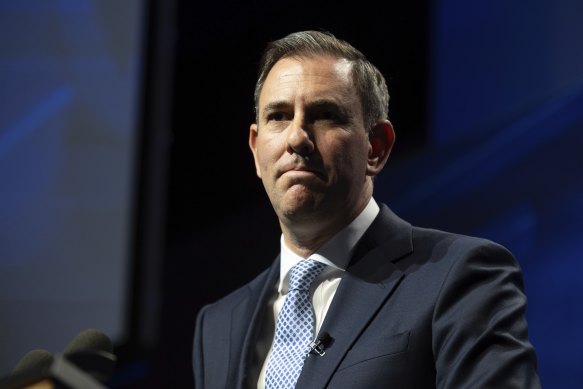No smiling matter: Chalmers’ inflation reprieve is hiding some economic frowns
Inflation figures this week have probably stopped the Reserve Bank from further interest rate rises, but the economy on Jim Chalmers’ watch is still struggling.
By Shane Wright
There was just the hint of a smile on the face of Treasurer Jim Chalmers as he stood up for a press conference to comment on this week’s inflation figures.
Not a broad grin, or a smirk, or even a twinkle. But there was enough in his face to show that he knew those figures meant the chance of an increase in official interest rates at the Reserve Bank’s meeting next week had plummeted.
After he worked his way through the numbers – inflation up by 1 per cent in the quarter, increasing slightly to 3.8 per cent over the year while underlying inflation eased to its lowest rate since early 2022 – questions moved to what they would mean for the RBA.

The federal government seems to have avoided an interest rate rise – but Treasurer Jim Chalmers knows the economy is struggling.Credit: Alex Ellinghausen
While his focus had been on the inflation data, Chalmers quickly turned to all the other issues the Reserve Bank board will have on its plate over its two-day meeting that starts on Monday.
“Headline inflation is precisely what the Reserve Bank forecast up to the June quarter. And underlying inflation is moderating,” he said.
“They will weigh all of that up along with the weakness that we’ve seen in the economy, the softening around the edges of the labour market. They’ll factor in conditions in the retail sector and all the rest of it.”
And it’s “the rest of it” that meant it was only a hint of a smile on the treasurer’s face as a range of other indicators suggest the economy is struggling.
The Reserve Bank has, since May 2022, lifted the official cash rate from a record low of 0.1 per cent to 4.35 per cent. It’s the most aggressive tightening of monetary policy since the late 1980s, when the bank helped drive the economy into a devastating recession.
Inflation peaked in late 2022 at 7.8 per cent, fuelled by a combination of COVID-era stimulus measures from governments and the Reserve Bank, supply chain bottlenecks across the globe and Russia’s invasion of Ukraine.
Since then, inflation has eased but not fast enough for many. As Michael Blythe, co-founder and chief economist at PinPoint Macro Analytics noted, inflation has been above the Reserve Bank’s 2-3 per cent inflation target for 33 consecutive months.
Only Mexico, the United States and Canada have worse records.
But defenders of the bank have noted that inflation is falling, and on the RBA’s timeline.
The most recent figures did show a lift in annual inflation, but there were some odd reasons for the result.
Poor weather conditions and some disease problems helped push up the prices of blueberries, strawberries, capsicums and tomatoes through the quarter. They alone accounted for 12 per cent of the total increase in inflation.
Government-mandated increases to tobacco and alcohol taxes accounted for another 11 per cent. The global lift in petrol prices (now being unwound) contributed another 9 per cent.

Since RBA governor Michele Bullock raised concerns about hairdressing-led inflation, it has started to ease.Credit: iStock
That’s a third of the total increase in inflation beyond the control of the Reserve Bank and interest rates.
Last year, RBA governor Michele Bullock caused a stir when she noted that inflation was “increasingly home-grown and demand-driven”, with hairdressers, dentists, dining out and sporting services all experiencing strong price increases.
This week’s figures show a slowdown across all those sectors. Annual inflation for hairdressing and grooming services fell to 5.6 per cent, its lowest level since September 2022, while the quarterly result of 0.8 per cent was the lowest since the second half of 2021.
Dental service prices rose 0.5 per cent in the June quarter, meals out increased by 0.6 per cent and sporting and cultural services lifted by a modest 0.2 per cent.
Inflation control is at the heart of the Reserve Bank’s job. But, as the late 1980s proved, focusing solely on inflation can have catastrophic economic consequences.
Separate figures released at the same time as the inflation data showed the volume of retail goods and services sold in the June quarter fell by 0.3 per cent to be 0.6 per cent lower over the past year.
In volume terms, retail sales have fallen by $256 a person since the Reserve Bank started lifting rates.
The economy grew by just 0.1 per cent through the first three months of the year. Figures for the June quarter, due early next month, will be almost as weak given the drop in retail activity.
Home value data from CoreLogic during the week also hinted at the economy’s slowdown.
While values nationally lifted in July, the 18th successive monthly rise, the pace of that increase eased. The 0.5 per cent lift in values was the smallest since December last year, while the annual pace of growth eased to a nine-month low.
In the cities with the biggest mortgages – Sydney and Melbourne – the pain caused by the RBA’s previous rate rises and overall cost-of-living pressures are clear.
After peaking in the September quarter of 2022 (when the cash rate got to 2.35 per cent), the volume of retail sales across NSW has fallen by 3 per cent, while in Victoria it has dropped by 2.1 per cent. That’s despite the two states adding a combined half a million residents over that period.
The labour market, one of the last parts of the economy to react to interest rate changes, is also signalling issues ahead. Unemployment has climbed by 0.6 percentage points over the past year while the number of job vacancies has fallen by a quarter.
Westpac chief economist Luci Ellis, a former RBA assistant governor, believes official interest rates could start falling from November.
Based on the Reserve Bank’s forecasts, it still believes inflation will be around 3.8 per cent by year’s end.
But Ellis noted that interest rates act with a lag. A central bank that waits until inflation is back within its target band before it starts easing monetary policy will hurt its economy, with the cost measured in unemployment.
“So rate cuts are on the cards,” she said.
Cut through the noise of federal politics with news, views and expert analysis. Subscribers can sign up to our weekly Inside Politics newsletter.